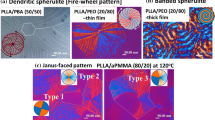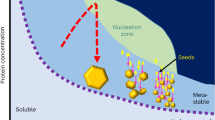Abstract
SILVER bromide has the sodium chloride-type structure, so that a perfect crystal, growing in a uniform environment, would not be expected to show any tendency to unsymmetrical growth. The fact that dispersions of silver bromide in gelatin, for example in photographic emulsions, can be obtained which do consist of regular polyhedra (Fig. 1) shows that a uniform environment for growth can be obtained. In the same environment during growth, but with different conditions of nucleation, however, dispersions can be obtained in which the crystals are tabular, the tabular faces having triangular or hexagonal shapes (Fig. 2). It can be shown that under identical environmental conditions, the uniform growth in three dimensions of the regular polyhedral crystals proceeds much more slowly than the ‘outward’ growth of the tabular crystals, that is, the tabular growth is due to enhanced growth parallel to the tabular faces rather than to repression of growth on these faces.
This is a preview of subscription content, access via your institution
Access options
Subscribe to this journal
Receive 51 print issues and online access
$199.00 per year
only $3.90 per issue
Buy this article
- Purchase on Springer Link
- Instant access to full article PDF
Prices may be subject to local taxes which are calculated during checkout
Similar content being viewed by others
References
Evans, T., and Mitchell, J. W., in “Report on Bristol Conference on Defects in Solids”, 409 (Physical Society, London, 1955).
Author information
Authors and Affiliations
Rights and permissions
About this article
Cite this article
BERRIMAN, R., HERZ, R. Twinning and the Tabular Growth of Silver Bromide Crystals. Nature 180, 293–294 (1957). https://doi.org/10.1038/180293a0
Issue Date:
DOI: https://doi.org/10.1038/180293a0
This article is cited by
-
Unusual 4H-phase twinned noble metal nanokites
Nature Communications (2019)
-
Synthesis of hexagonal and triangular Fe3O4 nanosheets via seed-mediated solvothermal growth
Nano Research (2014)
-
Observation of Coalescence Process of Silver Nanospheres During Shape Transformation to Nanoprisms
Nanoscale Research Letters (2011)
-
Investigation of precipitated colloidal particles by scanning force microscopy: silver-halide microcrystals
Applied Physics A Solids and Surfaces (1994)
Comments
By submitting a comment you agree to abide by our Terms and Community Guidelines. If you find something abusive or that does not comply with our terms or guidelines please flag it as inappropriate.



